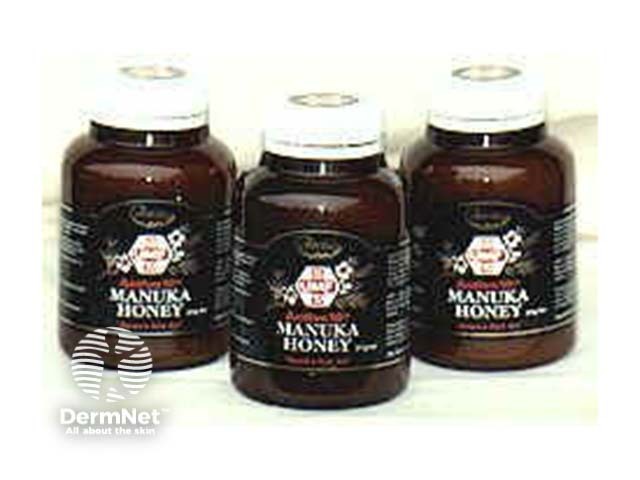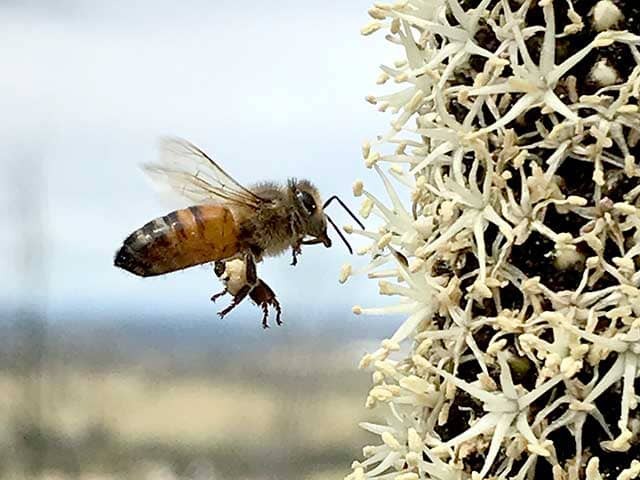Main menu
Common skin conditions

NEWS
Join DermNet PRO
Read more
Quick links
Honey in wound care — extra information
Honey in wound care
Last Reviewed: January, 2024
Author(s): Dr Hamish Wu, Auckland; Jihee Sun, Medical Student; and Dr Yena Kim, Dermatologist, Middlemore Hospital, Auckland, New Zealand (2024)
Previous contributors: Vanessa Ngan, Staff Writer (2005)
Reviewing dermatologist: Dr Ian Coulson
Edited by the DermNet content department
Introduction
Definition
How it works
Uses
Types of honey
How to use
Benefits
Cautions
Introduction
For centuries, honey has been used as an effective remedy for wounds, burns, and ulcers. In recent years there has been renewed interest in honey’s medicinal properties.
What is honey and why is it used in wound care?
Honey is a supersaturated sugar solution made by bees. It is primarily made up of fructose and glucose, as well as minor components including proteins, enzymes, amino acids, minerals, and vitamins.
Honey’s remarkable antibacterial and wound-healing properties are attributable to its:
- High sugar content and low pH which prevent bacterial growth
- Production of hydrogen peroxide, an antiseptic agent
- Wound-debriding action by drawing fluid from the wound and removing debris
- Anti-inflammatory properties which reduce local inflammation and pain
- Osmotic effect which reduces oedema and exudate production.

A medical grade honey applied to a dressing before wound application

Medical grade honey

The kind donor of this product
How does honey work to treat infections?
Many features in the composition of honey together give it antimicrobial properties.
Feature |
Antimicrobial action |
|
|---|---|---|
High osmolality |
Honey is a saturated or supersaturated solution of sugars that has strong interaction with water molecules. The lack of ‘free’ water inhibits the growth of microorganisms. |
|
When honey is diluted by wound exudates, hydrogen peroxide is produced via a glucose oxidase enzyme reaction. This is released slowly to provide antibacterial activity but does not damage tissue. However, acidity, catalase and protein-digesting enzymes in wound fluids may reduce the effectiveness of hydrogen peroxide. |
||
Antibacterial phytochemicals |
Some kinds of honey still have antimicrobial activity even when hydrogen peroxide activity has been removed. The honey from mānuka trees (Leptospermum scoparium) has been found to have high levels of antibacterial phytochemicals. |
|
Honey also appears to stimulate lymphocytic and phagocytic activity, which are key body immune responses in the battle against infection.
What conditions is honey used to treat?
Honey is most commonly used as a topical antibacterial agent to treat infections in a wide range of wound types. These include:
- Minor cuts and abrasions
- Burns
- Infected wounds following injury or surgery
- Necrotic and sloughy wounds
- Various ulcers including venous, arterial, diabetic foot, and pressure ulcers.
In many cases, honey is used when conventional antibacterial treatment with antibiotics and antiseptics are ineffective.
Honey can also be used as a first-aid treatment for burns as it has anti-inflammatory activity.
Types of honey used in wound care
Medical-grade honey used for wound care is sterilised and laboratory-tested. It is available in various forms including creams, gels, pastes, and impregnated dressings. These products can be made from various types of honey, including but not limited to polyfloral, buckwheat, and mānuka honey.
Different types of honey exhibit differences in antimicrobial activity. Honey from different sources has been studied, and a few types have been identified as having particularly high antibacterial activity.
Mānuka honey
Mānuka honey is gathered from the mānuka tree, Leptospermum scoparium, which is native to New Zealand. It has high antibacterial activity, with about half of this type of honey having high levels of non-peroxide activity. This means that even after the hydrogen peroxide is neutralised, it still exhibits substantial antibacterial activity.
Honey produced from mānuka trees is tested for antibacterial activity and is given a potency rating called a UMF (Unique Mānuka Factor). The honey is tested for the key signature compounds leptosperin, methylglyoxal, and dihydroxyacetone. The higher the UMF rating, the greater the level of UMF properties.
Medical-grade UMF honey is sterilised by gamma irradiation, without loss of antibacterial activity.
Applying honey in wound care
- Sterilised, laboratory-tested honey for medicinal purposes should be used to treat infected wounds.
- The amount of honey used depends on the amount of fluid exuding from the wound. Large amounts of exudate require substantial amounts of honey to be applied.
- The frequency of dressing changes depends on how rapidly the honey is being diluted by the exudate. This should become less frequent as the honey starts to work on healing the wound.
- Occlusive dressings help to prevent honey oozing out from the wound.
- It is best to spread the honey on a dressing and apply this to the wound, rather than applying the honey directly onto the wound. Dressing pads pre-impregnated with honey are commercially available and provide an effective and less messy option.
- Abscesses, cavities, or deep wounds need more honey to adequately penetrate deep into the wound tissues. The wound bed should be filled with honey before applying the honey dressing pad.
What are the benefits of honey in wound care?
- Honey is effective against a wide range of bacteria, including those resistant to antibiotics.
- Honey aids in autolytic debridement; it helps to facilitate the removal of dead tissue from the wound and promotes the growth of new, healthy tissue.
- By reducing the bacterial load, honey can help mitigate wound odour.
- Honey is generally non-toxic, hypoallergenic and well-tolerated, making it safe for most individuals, including those with sensitive skin or allergies to other wound care products.
What are the cautions when using honey in wound care?
- Avoid if allergic to bee products.
- Stinging or discomfort upon honey application may be experienced.
- Severe burns or deep wounds may be inadequately treated with honey alone, therefore professional medical supervision is advised.
References
- Al-Waili N, Salom K, Al-Ghamdi A. Honey for wound healing, ulcers, and burns; data supporting its use in clinical practice. ScientificWorldJournal. 2011;11:766–787. doi: 10.1100/tsw.2011.78. Journal
- Cooper RA, Molan PC, Harding KG. Antibacterial activity of honey against strains of Staphylococcus aureus from infected wounds. J R Soc Med. 1999;92(6):283–285. doi: 10.1177/014107689909200604. Journal
- Cooper R, Molan P, Krishnamoorthy L, Harding K. Manuka honey used to heal a recalcitrant surgical wound. Eur J Clin Microbiol Infect Dis. 2001 Oct;20(10):758–9. doi: 10.1007/s100960100590. Journal
- Hermanns R, Mateescu C, Thrasyvoulou A, et al. Defining the standards for medical grade honey. Journal of Apicultural Research. 2020;59(2):125–135. doi: 10.1080/00218839.2019.1693713. Journal
- Jull AB, Cullum N, Dumville JC, et al. Honey as a topical treatment for wounds. Cochrane Database Syst Rev. 2015;2015(3):CD005083. Journal
- Mandal MD, Mandal S. Honey: its medicinal property and antibacterial activity. Asian Pac J Trop Biomed. 2011;1(2):154–160. doi: 10.1016/S2221-1691(11)60016-6. Article
- Minden-Birkenmaier BA, Bowlin GL. Honey-Based Templates in Wound Healing and Tissue Engineering. Bioengineering (Basel). 2018;5(2):46. doi: 10.3390/bioengineering5020046. Journal
- Nolan VC, Harrison J, Wright JE, Cox JA. Clinical significance of manuka and medical-grade honey for antibiotic-resistant infections: a systematic review. Antibiotics. 2020;9(11):766. doi: 10.3390/antibiotics9110766. Journal
- Yaghoobi R, Kazerouni A, Kazerouni O. Evidence for Clinical Use of Honey in Wound Healing as an Anti-bacterial, Anti-inflammatory Anti-oxidant and Anti-viral Agent: A Review. Jundishapur J Nat Pharm Prod. 2013 Aug;8(3):100–4. doi: 10.17795/jjnpp-9487. Article
On DermNet
Other websites
- Medical honey simplified (PDF) — Oxford Health, NHS Foundation Trust
